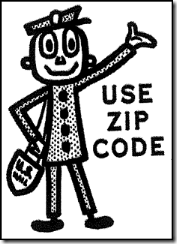Selling the Business Benefits of Data Quality
/
“Very few organizations have as timid an audience as the United States Postal Service,” explained Godin. “Dominated by conservative big customers, the Postal Service has a very hard time innovating. The big direct marketers are successful because they’ve figured out how to thrive under the current system. Most individuals are in no hurry to change their mailing habits, either.”
“The majority of new policy initiatives at the Postal Service are either ignored or met with nothing but disdain. But ZIP+4 was a huge success. Within a few years, the Postal Service diffused a new idea, causing a change in billions of address records in thousands of databases. How?”
Doesn’t this daunting challenge sound familiar? An initiative causing a change in billions of records across multiple databases?
Sounds an awful lot like a massive data cleansing project, doesn’t it? If you believe selling the business benefits of data quality, especially on such an epic scale, is easy to do, then stop reading right now—and please publish a blog post about how you did it.
Going Postal on the Business Benefits
Getting back to Godin’s case study, how did the United States Postal Service (USPS) sell the business benefits of ZIP+4?
“First, it was a game-changing innovation,” explains Godin. “ZIP+4 makes it far easier for marketers to target neighborhoods, and much faster and easier to deliver the mail. ZIP+4 offered both dramatically increased speed in delivery and a significantly lower cost for bulk mailers. These benefits made it worth the time it took mailers to pay attention. The cost of ignoring the innovation would be felt immediately on the bottom line.”
Selling the business benefits of data quality (or anything else for that matter) requires defining its return on investment (ROI), which always comes from tangible business impacts, such as mitigated risks, reduced costs, or increased revenue.
Reducing costs was a major selling point for ZIP+4. Additionally, it mitigated some of the risks associated with direct marketing campaigns, such as the ability to target neighborhoods more accurately, as well as reduce delays in postal delivery times.
However, perhaps the most significant selling point was that “the cost of ignoring the innovation would be felt immediately on the bottom line.” In other words, the USPS articulated very well that the cost of doing nothing was very tangible.
The second reason ZIP+4 was a huge success, according to Godin, was that the USPS “wisely singled out a few early adopters. These were individuals in organizations that were technically savvy and were extremely sensitive to both pricing and speed issues. These early adopters were also in a position to sneeze the benefits to other, less astute, mailers.”
Sneezing the benefits is a reference to another Seth Godin book, Unleashing the Ideavirus, where he explains how the most effective business ideas are the ones that spread. Godin uses the term ideavirus to describe an idea that spreads, and the term sneezers to describe the people who spread it.
In my blog post Sneezing Data Quality, I explained that it isn’t easy being sneezy, but true sneezers are the innovators and disruptive agents within an organization. They can be the catalysts for crucial changes in corporate culture.
However, just like with literal sneezing, it can get really annoying if it occurs too frequently.
To sell the business benefits, you need sneezers that will do such an exhilarating job championing the cause of data quality, that they will help cause the very idea of a sustained data quality program to go viral throughout your entire organization, thereby unleashing the Data Quality Ideavirus.
Getting Zippy with it
One of the most common objections to data quality initiatives, and especially data cleansing projects, is that they often produce considerable costs without delivering tangible business impacts and significant ROI.
One of the most common ways to attempt selling the business benefits of data quality is the ROI of removing duplicate records, which although sometimes significant (with high duplicate rates) in the sense of reduced costs on the redundant postal deliveries, it doesn’t exactly convince your business stakeholders and financial decision makers of the importance of data quality.
Therefore, it is perhaps somewhat ironic that the USPS story of why ZIP+4 was such a huge success, actually provides such a compelling case study for selling the business benefits of data quality.
However, we should all be inspired by “Zippy” (aka “Mr. Zip” – the USPS Zip Code mascot shown at the beginning of this post), and start “getting zippy with it” (not an official USPS slogan) when it comes to selling the business benefits of data quality:
- Define Data Quality ROI using tangible business impacts, such as mitigated risks, reduced costs, or increased revenue
- Articulate the cost of doing nothing (i.e., not investing in data quality) by also using tangible business impacts
- Select a good early adopter and recruit sneezers to Champion the Data Quality Cause by communicating your successes
What other ideas can you think of for getting zippy with it when it comes to selling the business benefits of data quality?
Related Posts
The Only Thing Necessary for Poor Data Quality
Hyperactive Data Quality (Second Edition)
Data Quality: The Reality Show?


